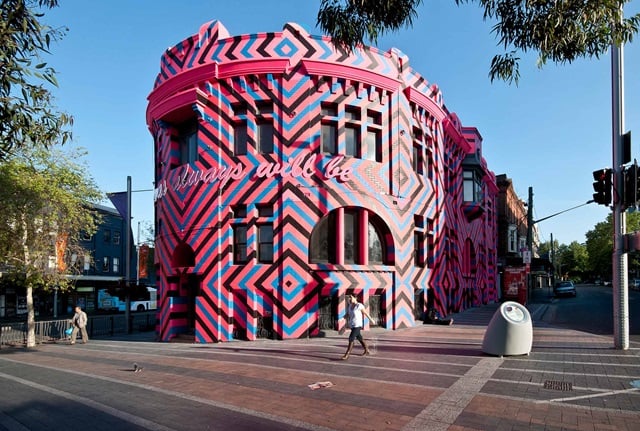


A large sundial commemorating the bicentenary of Lieutenant James Cook’s landing at Botany Bay in 1770.
Artwork description
The sundial commemorates the bicentenary of Lieutenant (later Captain) James Cook’s landing at Botany Bay. Cook charted the east coast of Australia in 1770, claiming the eastern seaboard of the continent for the British Crown. It was not considered the official bicentenary of Australia, but rather the bicentenary of the first mapping of Australia’s eastern coastline. It was made by Sundials Australia and installed in 1970.
The large cement and pebblecrete sundial is made of hollow steel and painted white. It is at the centre of a circular pebblecrete area with seating around its perimeter and is located on Raglan Street, Waterloo. Embedded in a circular base is a stylised map of Australia and New Zealand documenting the route of the Endeavour.
The east-west arm of the sundial has raised numbers and periods representing the time. A metal bar extends from the north arm to the south arm and its shadow indicates the time.
More information
Following advice from the Aboriginal and Torres Strait Islander Advisory Panel, Council voted in July 2011 to use the word ‘invasion’ in the City of Sydney Aboriginal and Torres Strait Islander protocols to more accurately describe the arrival of Europeans in Australia in 1788. The plan noted the following:
“Despite the destructive impact of this invasion, Aboriginal culture endured and is now globally recognised as one of the world's oldest living cultures. Aboriginal peoples have shown, and continue to show, enormous resilience coupled with generosity of spirit towards other peoples with whom they now share their land.
“The Council of the City of Sydney recognises that, by acknowledging our shared past, we are laying the groundwork for a future which embraces all Australians, a future based on mutual respect and shared responsibility for our land.”
This position paved the way for continuing conversations about how we might address monuments in our collection that don’t accurately acknowledge our shared history. This work is ongoing.







